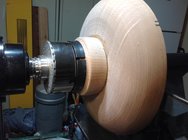Well, just saw this on You Tube last night:
View: https://www.youtube.com/watch?v=Ygys75Lvav8
I guess they do work, but the only time I use glue blocks is when making boxes. When making a recess or tenon, I am never more than 1/8 inch deep because you don't need the depth as much as you need the proper size for what you are turning. Never use face plates either, other than for one huge, 22 inch diameter bowl, I turned years ago. I would have needed a 5 or so inch set of jaws to have mounted it, and I don't think they make forstner bits that big. Most of my bowls are under 14 inch diameter.
robo hippy

